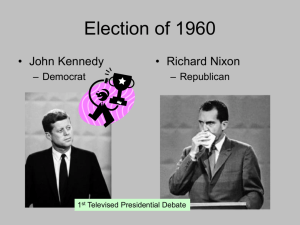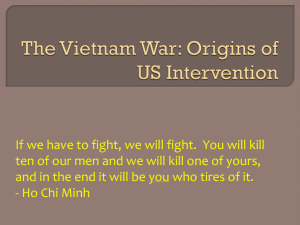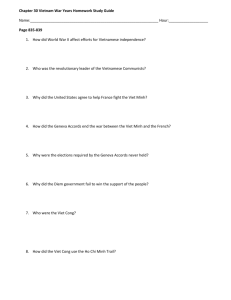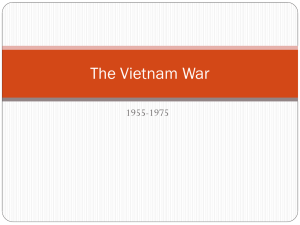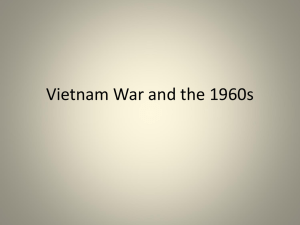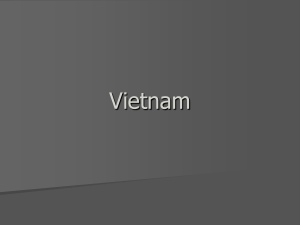The End of Empire - Miami Beach Senior High School
advertisement
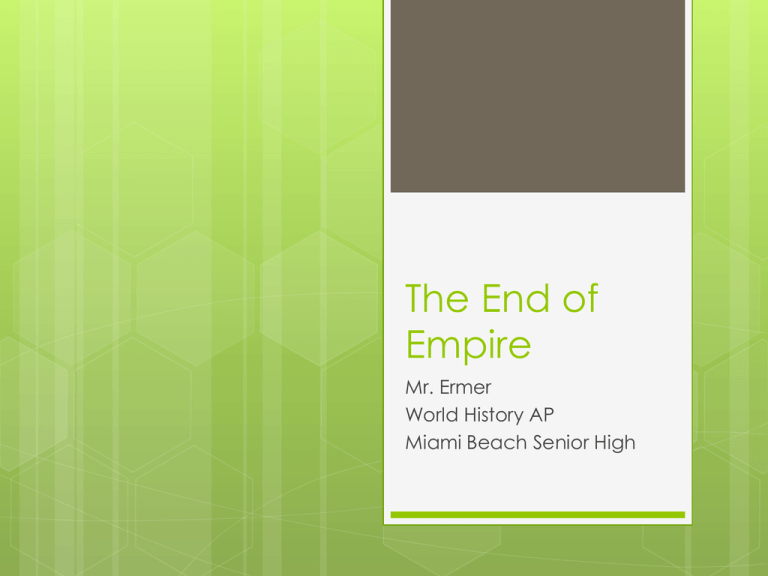
The End of Empire Mr. Ermer World History AP Miami Beach Senior High India After WWII, Asian nations seek independence Winston Churchill suspends self-rule initiatives Succeeded by Labor PM Clement Attlee Attlee more inclined toward dismantling empire As India moves closer toward independence, communalism on the rise Communalism stresses religious rather than national identity (Great Calcutta Killing) Nehru and Gandhi against partition of India August 15, 1947: India and Pakistan created, freed Gandhi predicts “rivers of blood,” refugees migrate Rivalries build between the two states Indian independence inspires movements elsewhere Nonaligned War Movement: resists picking sides in Cold 1947: Partition of British India Vietnam Vietnam The United States supported French claim to colonies Vietnamese Nationalist leader, Ho Chi Minh, leads communist Viet Minh against France Issues Vietnamese Declaration of Independence China sends military aid to Viet Minh 1954: Viet Minh defeat French at Dienbienphu The fights post-war France for independence Geneva Conference Partitioning of Vietnam along seventeenth parallel North Vietnam: Communist with capital at Hanoi South Vietnam: non-communist with capital at Saigon Ngo Dinh Diem: president of South Vietnam with U.S. support Diem’s cruel rule unpopular among Vietnamese in south 1960: National Liberation Front (NLF) fights against Diem’s forces Buddhists practice self-immolation French Indochina War in Vietnam Dwight D. Eisenhower applies Domino Theory Kennedy also applies theory, increases aid to Diem President Johnson increases direct U.S. involvement Fight NLF “Viet Cong” in south, bomb the north Ho Chi Minh patiently fights against foreign influence—war of attrition Support for war declines in the U.S. President Nixon calls for vietnamization Replacing of American forces with South Vietnamese Opens dialogue with Soviets and Chinese 1973: Paris Peace Accords Northern forces defeat the South in 1975 Reunification of Vietnam in 1976 Israel/Palestine Under mandate system, British made conflicting promises to Palestinian Arabs and Jewish migrants 1917: Zionist Balfour Declaration lends British support European Jews seek homeland, protection Zionism gains steam across Europe Britain allows migration of settler Jews to Palestine British limit Jewish migration to Palestine Pan-Arab Nationalism grows in opposition to Zionism Promise to protect Palestinian rights After Holocaust, Zionist commitment increases in Jews 1945: Violent Jewish resistance to Palestinian and British rule—King David Hotel bombing of 1946 1947: Britain hands Palestine over to United Nations Partition of Palestine into two states, Jewish and Arab Civil War erupts, Palestinians see partition as unacceptable 1948: Jewish forces proclaim creation of State of Israel Series of conflicts helps Israel expand territory Egypt Egypt leads Arab world against Israel 1952: Egyptian military ousts King Farouk Gamal Abdel Nasser and Egyptian military in power Eschew democracy and constitutional government Suppress communists and Muslim Brotherhood 1954: Nasser names self prime-minister Militarization and industrialization Nasser sees Cold War alliances as new imperialism Joins Nehru’s nonaligned movement Condemns Baghdad Pact Gets assistance from both U.S. and Soviets Sends aid to Algerians fighting French Opposes Israel as a settler colony of Europeans Abolished British military control of Suez Canal Africa 1954: French begin to fight for control of Algeria 1954-1960: Most other French African colonies freed French fight the Front de Libération Nationale (FNL) 1962: Algeria gains independence, Frantz Fanon writes 1960: The Year of Africa African elites form cultural and political institutions 1957: Ghana gains independence from Britain Kwame Nkrumah becomes leader, African symbol 1955: FNL moves into urban areas, France sends troops Non-violence and mass action Kenya fights for independence, bloody conflict South Africa’s apartheid regime 1948: Afrikaner National Party comes to power Creates racially segregated society African National Congress fights for equality 1989: F. W. de Klerk negotiates transition with Nelson Mandela Communist China Mao Zedong’s CCP reunifies China China emulates Soviet style Five Year Plans in 1955 Build infrastructure and heavy industry Collectivization of agricultural lands Women’s rights The Great Leap Forward (1958-1961) Failed attempt to overtake other economies by collectivization of entire economy The Cultural Revolution (1966-1976) Targeted Many beaten, jailed, killed by young zealots, damages unity Deng teachers, artists, elites, professionals Xiaoping succeeds Mao in 1981 Opens trade with West, undoes some of Mao’s ideas Tiananmen Square Indian Democracy 1966: Indira Gandhi is leader of Congress Party Serves as prime minister 1966-1977, 1980-1984 Institutes Green Revolution Experiences challenges in keeping India united Sectarian violence Out of control birth rates Government sterilization programs Amritsar genocide of Sikhs Gandhi assassinated by Sikh bodyguards in 1984 Rajiv Gandhi takes power in 1985, assassinated in 1991 The Middle East 1970: Rise of Islamism and Pan-Arab Nationalism Many Muslims lament loss of Islamic values, sharia Rise of Pan-Islamic unity, extremism Western social norms blamed for decline of Islamic societies, secularization, political failures The Anger directed toward Europe and the United States Extremists use concept of jihad to legitimize terrorism Iranian Revolution U.S. support of Shah Pahlavi militarizes Iran Oil money helps Iran industrialize, Islamism on the rise Many Students, small business owners, liberal politicians oppose Shah Ayatollah Khomeini leads Islamic Revolution in 1979 resent influence of foreign oil companies, gov’ts Revolution strongly anti-American Iraq’s Saddam Hussein invades Iran to take advantage Iraq-Iran War lasts until 1988 Argentina Transformation of pampas to farmlands Controlled by oligarquia with government support European upper-class creates urban culture in Buenos Aires, support British business European & American goods make up most manufactured goods in Argentina, railroads speak English 1920s: Increased ties and trade with US and Europe Rapid industrialization, prosperity Series Hipolito Irigoyen elected president of military coups ends with Juan Peron’s rise At first creates Nazi inspired fascist/military government After Nazi’s lose, Peron reinvents his politics Eva Duarte Peron’s championing of the descamisados 1946: Perons establish populist dictatorship
![vietnam[1].](http://s2.studylib.net/store/data/005329784_1-42b2e9fc4f7c73463c31fd4de82c4fa3-300x300.png)
